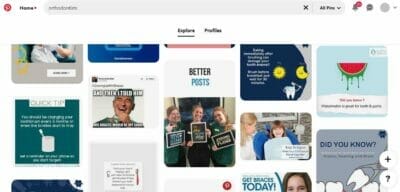This ultimate guide on SEO for plastic surgeons will bless you with all the knowledge you need to acquire new patients using search engine optimization. By following this guide, you will learn innovative ways to increase traffic while ranking closer and closer to #1 on Google search results. Improving your plastic surgery SEO not only reaches new patients but also builds the trust they need when choosing a facility. If your website is not one of the first results to appear on Google, then potential patients will likely choose a competitor’s private practice.
Using this guide, you will learn innovative ways to increase traffic while ranking closer and closer to #1 on Google search results. Here is a quick, successful seo case study for a plastic surgeon.
Table of Contents
ToggleSEO for Plastic Surgeons
SEO stands for search engine optimization, which is the methodology of improving a website to rank higher on search engines. Eventually, this will result in more organic visitors viewing the website, creating new and more patients.
Google’s high-tech algorithms are made to provide users with the best answers. This is why ranking is very important to SEO, and everyone is striving to rank number 1. With the ranking system of SEO changing every day, marketers have to stay on top of the frequent updates to not risk missing out on potential patients.

Understand that you need to use Google’s algorithm to your advantage. Make sure that Google knows what your website is about, so it can create visibility for your audience.
There are two main factors you need to consider when using SEO strategies: patience and consistency. Now, as you may know, using successful SEO does not guarantee the final result overnight. This can be an exhausting process, but the work pays off in the long run.
Good plastic surgery SEO starts with outstanding content. You want your patients to find your content so valuable that they are inclined to share it with others. By providing good content and experience, you are increasing your traffic, which in the long run will create more revenue for your company.
If you are ever interested in expanding your company’s brand using Google Ads or Facebook Ads, you can check out one of our following articles. These articles will run you through step-by-step guidelines on how to advertise your clinic using these digital platforms.
Why is SEO Important to Medical Marketers
All medical practices want the same goal, which is to have a constant flow of patients booking appointments.

Most people never scroll past the first page of Google, which means if you’re not near the top, you’re almost invisible to potential patients.
SEO makes sure your website is easy for Google to understand and recommend, so you show up higher in search results. This is huge for plastic surgeons because people are already looking for the exact services you offer; they just need to find you. Good SEO not only brings you more visitors, but the visitors you get are also more likely to become patients, since they are already searching with real interest.
Local SEO for Plastic Surgeons
Local SEO is all about helping people in your area find your business when they search online. Imagine someone types “plastic surgeon near me” or “best rhinoplasty in Los Angeles.” If your website and Google profile are well-optimized for local searches, your practice can show up at the top of the map results or in the first few listings. This matters because most patients prefer a surgeon who is close by.
To improve your local SEO, you must:
• Claim and update your Google Business Profile with correct name, address, phone number, and office hours.
• Ensure your business information (NAP: Name, Address, Phone number) is consistent everywhere online, like on Yelp, Healthgrades, and other directories.
• Encourage happy patients to leave positive reviews.
SEO vs Google Ads
When people want their website to show up on Google, they usually have two choices: SEO or Google Ads.
• SEO: You improve your site by adding good content, using the right keywords, and making it easy to use. It grows slowly, but once it is strong, it keeps bringing in visitors without extra cost.
• Google Ads: This is more like renting a billboard. You pay Google, and your website shows up at the very top of the search results right away. The big difference is that when you stop paying, the billboard disappears, and so do the visitors. Check out Google Ads for Plastic Surgeons to know more about Google Ads!
SEO takes more time and patience but keeps working for you in the long run, while Google Ads gives quick results but only lasts as long as your budget does. Many businesses, like plastic surgeons, actually use both: Google Ads to get patients right away and SEO to build lasting visibility that doesn’t depend on constant spending.
You can also check out our Case Study On Plastic Surgeon SEO.
Google Business Profile
A Google Business Profile (which used to be called Google My Business) is like a digital storefront for your practice that shows up when people search for services on Google. When someone types “plastic surgeons near me”, your profile can pop up on Google Maps and at the top of search results with your clinic’s name, phone number, address, website link, reviews, and even photos.
Having a complete and accurate profile is super important because many patients will look at this information before deciding whether to call you or book a consultation. The more details you add, like your office hours, the services you offer, before-and-after photos, and even short posts or updates, the more professional and trustworthy you’ll look. Plus, reviews from past patients show up right there, giving new patients confidence in your skills.
Think of your Google Business Profile as a free online business card that never gets lost and is always available to people searching in your area. If you keep it updated and encourage happy patients to leave reviews, it can become one of the strongest tools to bring in new clients without paying for ads.
Competitive Offer
In the world of plastic surgery, patients have lots of choices. They can go online and instantly find dozens of surgeons in the same city offering similar procedures. This is where having a competitive offer becomes important. A competitive offer is what makes your practice stand out from all the others.
It could be something like free consultations, flexible payment plans, special package deals (such as a “mommy makeover” bundle), or even just highlighting your unique expertise and years of experience. When you clearly explain what sets you apart, patients are more likely to choose you instead of another surgeon. From an SEO perspective, your competitive offer should also be visible on your website and Google Business Profile, so people see it right away when they search.
Think of it as your “extra reason” for patients to pick you. Without a strong competitive offer, even if your website ranks high, you might lose patients to a surgeon who clearly shows more value. By combining good SEO with a clear competitive offer, you not only get found you also convince people that you’re the best choice.
Want to rank number #1? We can help you!
Keyword Research for Plastic Surgeons
On browsers, people use keywords to search for specific content. Keywords are one of the main stepping stones for creating good content and high traffic volume.
Keywords can come in various forms. Using different types of keywords and phrases in your web content will increase your chance of getting more traffic to your site. More traffic means more appointment bookings, which will lead to more revenue for the company.
So, what kind of keywords should you use? It’s a trial-and-error process that every marketer has to endure. You need to research what keywords best fit and understand how your patients search when looking for types of services and resources.
Questions That Might Come Up When Keyword Researching:
- What is the consumer’s intent for searching?
- What is the consumer’s objective?
- How many people are searching for the same topic?
- What attracts the customers?
Monthly Search Volume
Monthly search volume tells you how many times people type a certain keyword into Google in one month. It’s like checking how popular a word or phrase is. For example, the keyword “rhinoplasty” might get tens of thousands of searches every month across the country, while a more specific keyword like “rhinoplasty cost in Los Angeles” might only get a few hundred. Both numbers are useful.
High search volume means lots of people are interested, but it also means lots of competition you’ll be going up against many other websites. Lower search volume means fewer people are searching, but those searches are often more specific and easier to rank for. For plastic surgeons, this balance is important. Big keywords like “plastic surgeon” may bring traffic, but long-tail ones like “best tummy tuck surgeon in Los Angeles” are more likely to bring real patients who are ready to book.
Keyword Difficulty
Keyword difficulty is a score that shows how hard it will be to rank on Google for a specific keyword. Think of it like a competition scale; the higher the difficulty, the more websites are already fighting to show up for that search. For example, a broad keyword like “plastic surgeon” will have very high difficulty because thousands of practices and large medical sites are trying to rank for it.
On the other hand, a more specific keyword like “rhinoplasty specialist in Los Angeles” will usually have lower difficulty, meaning you have a better chance of showing up near the top. Keyword difficulty is often measured on a scale from 0 to 100, with higher numbers meaning tougher competition.
Understanding keyword difficulty helps you build a smarter SEO strategy where you go after the “winnable” searches first, instead of wasting energy on keywords dominated by big hospitals or national health websites.
Using Relevant Keywords
Using relevant keywords means making sure the words on your website match what potential patients are actually searching for. If someone types “best facelift surgeon in Los Angeles,” but your website only says “we offer face procedures,” you probably won’t show up because the wording doesn’t match the search.
Relevant keywords connect the exact services you provide with the exact words patients use to find them. For plastic surgeons, this might include terms like “breast augmentation,” “liposuction,” “tummy tuck recovery,” or “Botox injections near me.” These keywords should appear naturally in important places on your site, like your page titles, headings, meta descriptions, image alt tags, and throughout your content.
But it’s not just about stuffing keywords everywhere. Google is smart enough to know if your content sounds fake or unnatural. The key is to write in a way that feels helpful to readers, while naturally including the terms they’re searching for. For example, on a rhinoplasty page, you might write: “Our rhinoplasty procedures in Los Angeles are designed to provide natural, balanced results with a safe recovery process.” This uses the keyword “rhinoplasty in Los Angeles” in a natural way.
By focusing on relevant keywords, you make it easier for Google to match your website with the right patients who are actively looking for your services.
Choosing The Right Target Keywords
Choosing the right target keywords is one of the most important steps in SEO, because these are the exact words and phrases you’ll focus on to attract patients. Not every keyword is worth your time; some are too broad and competitive, while others are so specific that barely anyone searches for them. The trick is to find the sweet spot: keywords that enough people are searching for, but that also match the services you provide and the intent of your ideal patients.
For plastic surgeons, a broad keyword like “plastic surgeon” may have thousands of searches, but it’s very hard to rank for and doesn’t always bring in patients ready to book. A more targeted keyword like “rhinoplasty surgeon in Los Angeles” or “tummy tuck recovery time” is easier to rank for and attracts patients who are actively considering those procedures. When choosing keywords, look at three things: relevance (does it match what you offer?), search volume (are enough people searching for it each month?), and difficulty (is it realistic to rank for this keyword?). By carefully choosing the right target keywords, you make sure your SEO efforts bring in not just more visitors but the right visitors who are most likely to turn into patients.
Short-Tail Keywords
Short-tail keywords are search terms that are made up of one to three words. They cover broader topics and are known to be the “head keyword”. These keywords are quite competitive and have a lot of search volume. This is why there are many nicknames for short-tail keywords, such as focus keywords, seed keywords, and even head terms.
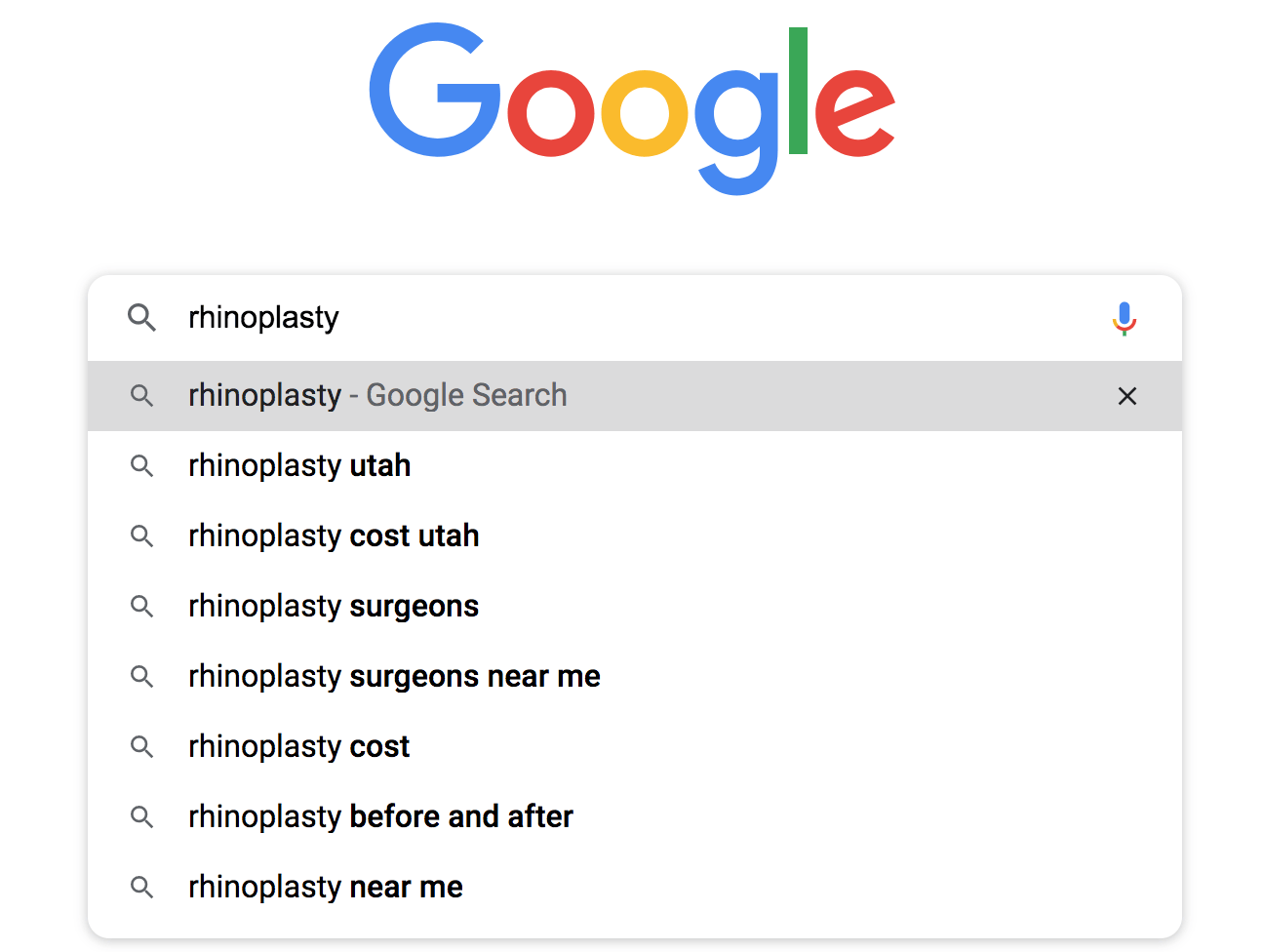
For example, if someone searches “rhinoplasty” you don’t know if they want to learn about the cost, the recovery, or to actually book the surgery. That makes it hard to know their true intent. For plastic surgeons, short-tail keywords are still important because they build overall visibility and can bring in people at the very start of their research journey.
However, they work best when combined with long-tail keywords that target patients who are closer to booking. In short, short-tail keywords give you a wide reach, but they’re harder to rank for and not always as valuable as the more specific searches.
Long-Tail Keywords
Long-tail keywords carry more than three words, aka making them longer keywords. More than 70% of keywords are long-tailed since they fall into a specific category. Users most likely use them when they are certain that they will purchase an item or a type of service.
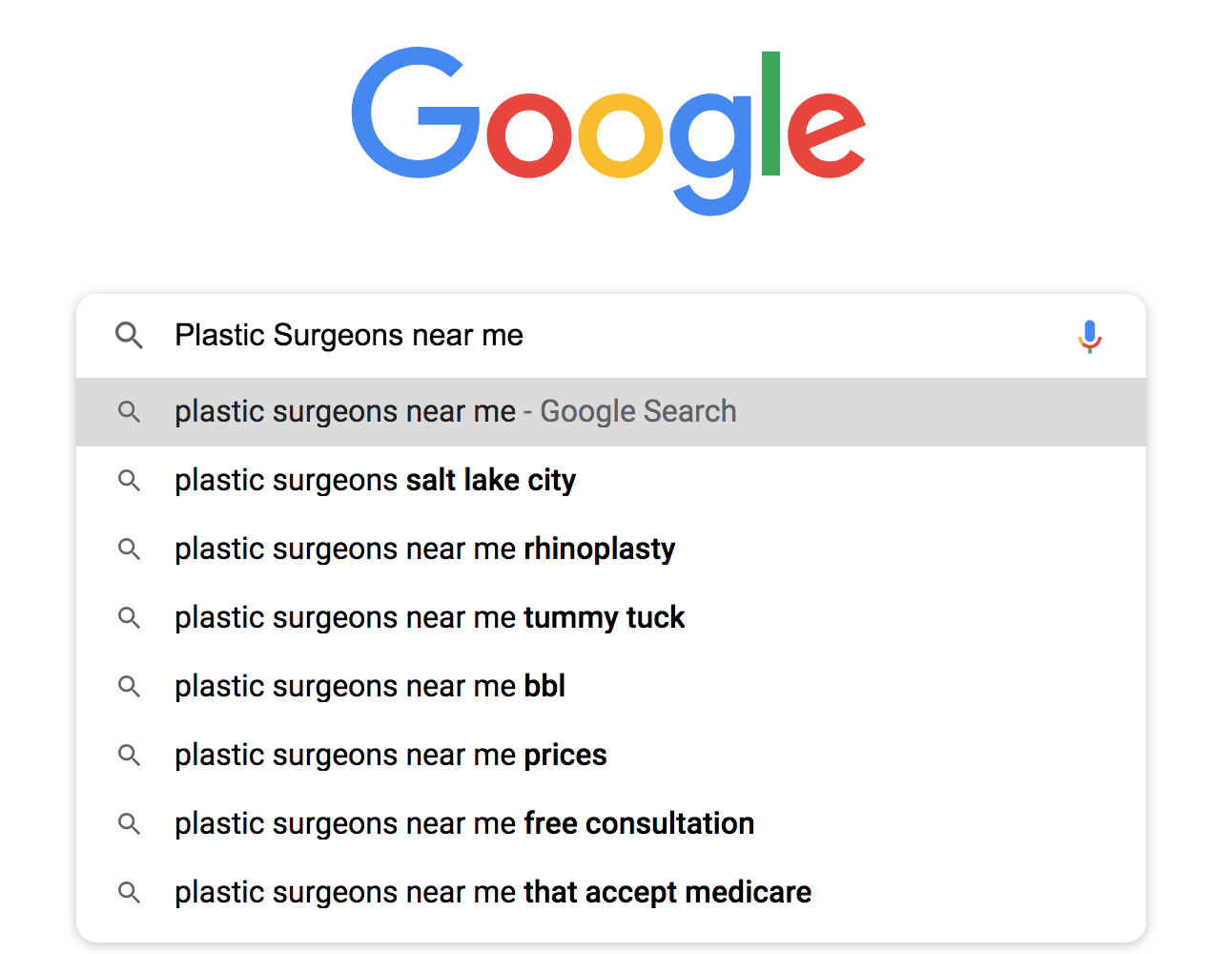
Unlike short keywords like “plastic surgeon” or “liposuction,” long-tail keywords usually include extra details, such as location, type of procedure, or even cost. For example, instead of searching “tummy tuck,” a patient might type “affordable tummy tuck surgeon in Los Angeles” or “tummy tuck recovery time after surgery.”
Even though long-tail keywords usually have fewer searches each month, they are powerful because they attract people who are closer to making a decision. For plastic surgeons, this often means patients who are ready to schedule a consultation. Another benefit is that long-tail keywords are usually less competitive, making it easier for your website to rank higher. They also sound more natural in your content, since they match the way real people speak or type their questions.
By focusing on long-tail keywords, you can bring in highly qualified traffic, people who aren’t just curious but are seriously considering plastic surgery and want answers now.
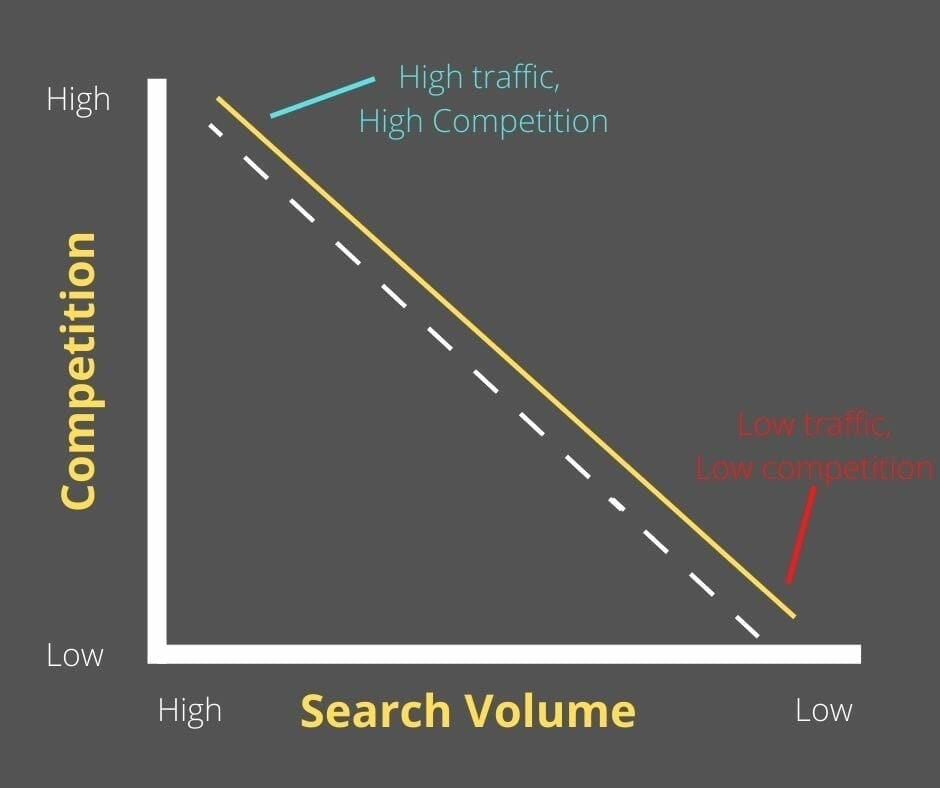
SEO Ranking Tools
With keywords being the foundation of SEO, we need some way of tracking them.
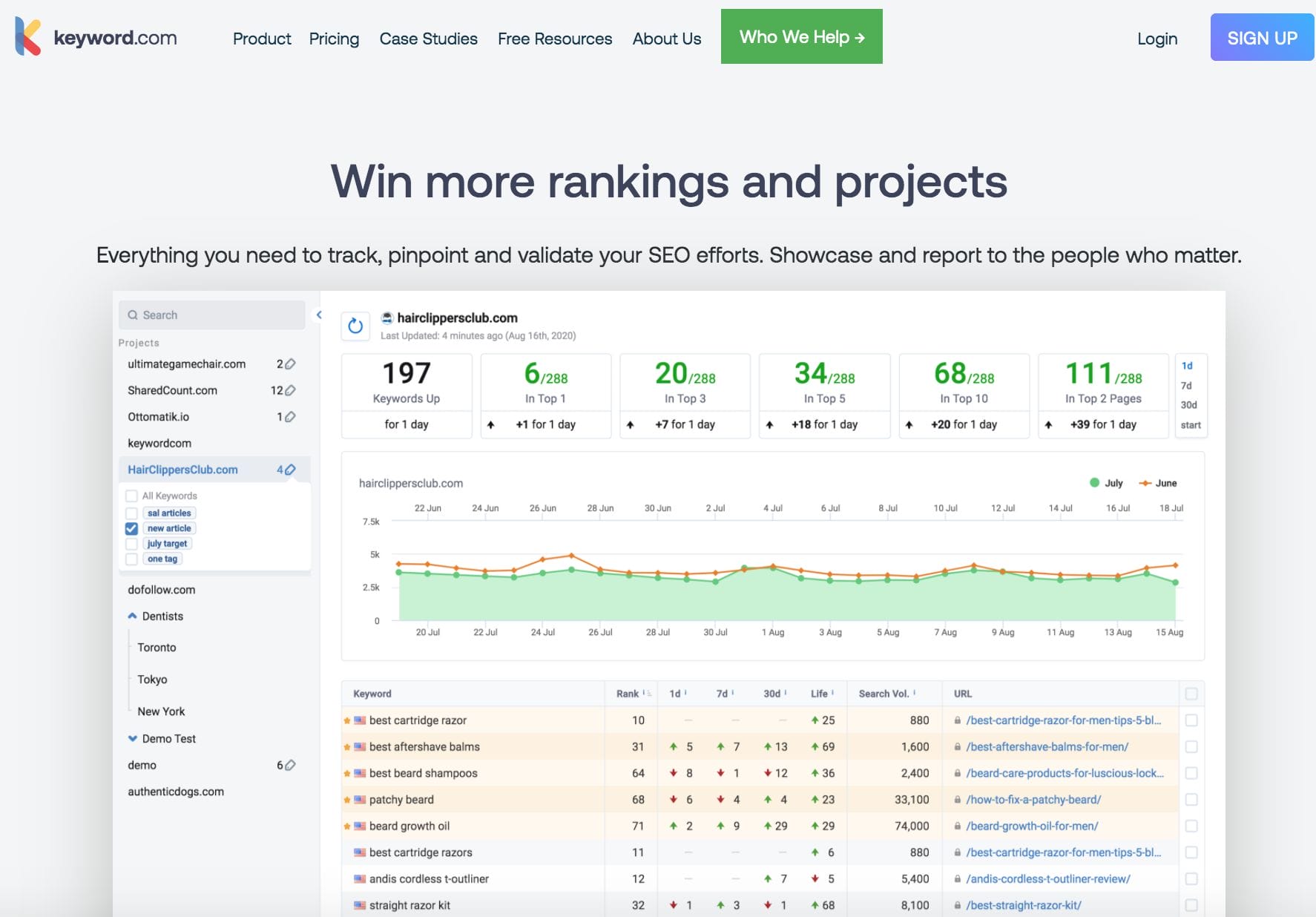
Software has been invented, such as Keyword.com, to help monitor a large group of keywords. Keyword.com is a paid software that analyzes and ranks your keywords. This tool analyses your visitors’ behaviors and shows you exactly what they are doing on your site. With this kind of knowledge, you can optimize your website so you can bring in more visitors.
Keyword.com is highly recommended to healthcare marketers who are just starting. This tool only requires $24 a month for the “starter” plan. It has cool features, such as its daily automatic Google rank checker. It compares your keywords with others and ranks them based on the competition.
Using this tool, you can input as many domains as you would like. Along with its analytical section, you can even monitor and compare your competition!
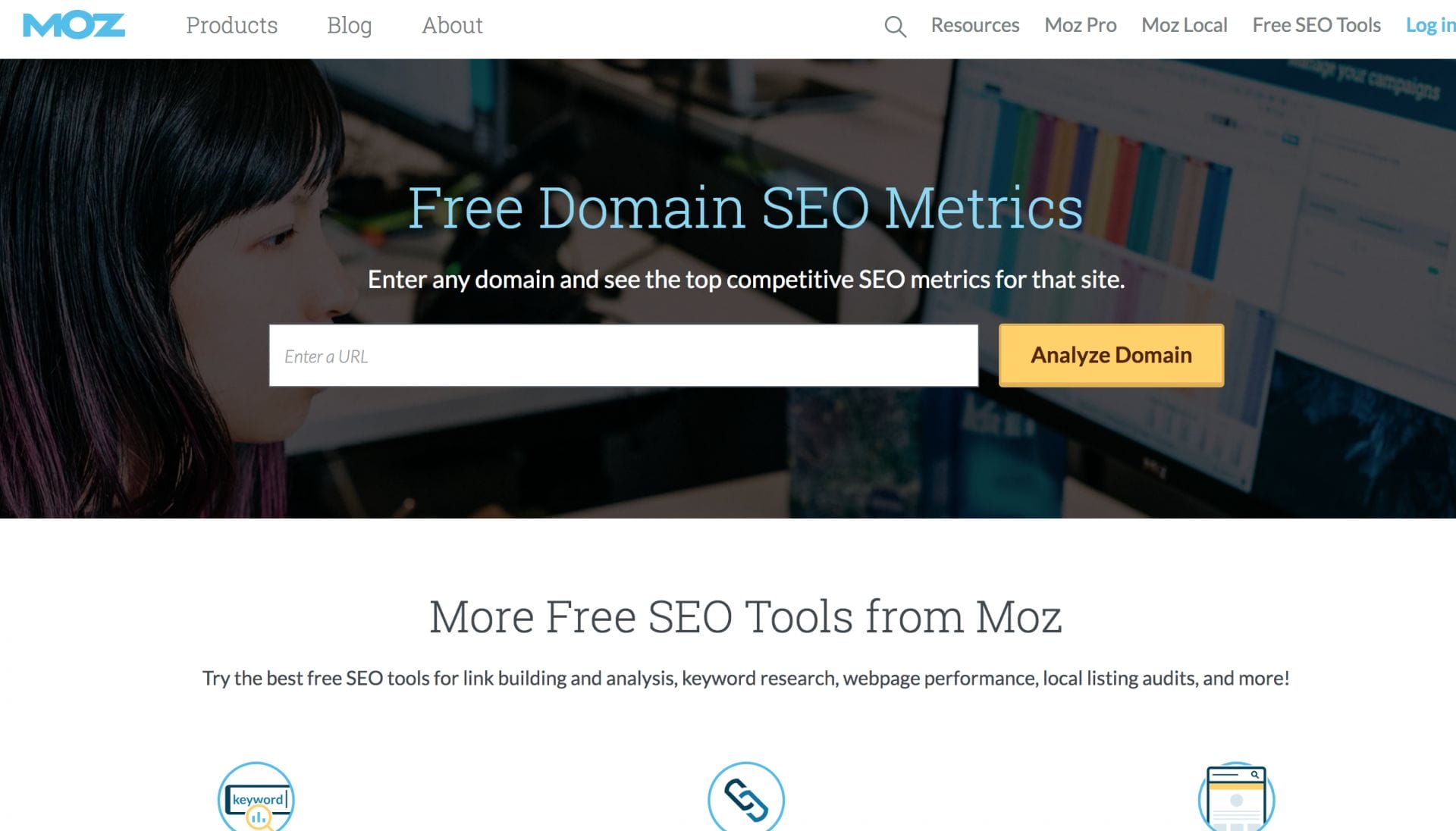
Another SEO tool that has seen some rise in the digital realm is called Moz. This tool allows marketers to analyze all organic performance of a website, along with doing a full examination of each competitor they would like to analyze. Moz offers keyword rank tracking and an opportunity for link building. We will go into further detail about link building in section 3.4.
This tool allows up to 800 keywords to research and up to 5,000 keyword search queries per month. Using their premium plan, you unlock a feature called “speed crawl”. This feature allows crawlers to view your internal link structure of the website you want to be crawled. After they analyze your website, they give feedback on how your site is performing and what can be further improved.
Google’s Autocomplete Predictions
Google’s Autocomplete Predictions are the suggestions that pop up under the search bar when you start typing something into Google. For example, if you type “rhinoplasty”, Google might suggest “rhinoplasty before and after,” “rhinoplasty recovery time,” or “rhinoplasty cost in Los Angeles.” This makes them a powerful, free tool for keyword research.
For plastic surgeons, using autocomplete can help you see what real patients want to know about your procedures. If you type in “tummy tuck” and see “tummy tuck scar healing” or “tummy tuck vs liposuction,” that tells you patients are curious about those topics, and you can create blog posts, FAQs, or service pages around them.
The best part is that autocomplete gives you long-tail keyword ideas that are specific and often less competitive, which means they’re easier to rank for. By using Google’s Autocomplete Predictions, you can stay in tune with patient concerns, answer their exact questions, and attract highly targeted visitors who are already searching for the services you provide.

Google’s Related Searches
Google’s Related Searches are the extra search suggestions that show up at the very bottom of the results page after you Google something. They are closely connected to the keyword you typed in and represent other things people often search for. For example, if you search “breast augmentation,” the related searches at the bottom might include “breast augmentation recovery time,” “breast augmentation before and after photos,” or “breast augmentation cost near me.”
For plastic surgeons, this is a simple but powerful way to discover new keyword ideas without paying for expensive SEO tools. These related searches show you what patients are curious about, what concerns they may have, and what comparisons they’re making before booking a procedure. By using them, you can expand your website content to answer more patient questions, for example, writing a blog about “breast augmentation recovery tips” or creating a service page that addresses “breast augmentation cost in Los Angeles.”
Since related searches are based on real user behavior, they help you create real content that matches patient intent, making it more likely for your site to show up in results. In short, Google’s related searches are like a free brainstorming tool that tells you exactly what your future patients want to know.

Google Keyword Planner
Google Keyword Planner is a free tool from Google that helps you find out what people are searching for and how often. It’s mainly designed for Google Ads, but it’s also very useful for SEO. For plastic surgeons, this tool can show you the average monthly search volume for keywords like “facelift surgeon near me” or “liposuction recovery time.” It also gives you ideas for new keywords you might not have thought about, along with the level of competition, whether lots of other websites and ads are targeting the same keyword, or not.
One of the best parts of Google Keyword Planner is that it lets you see searches by location. This is especially important for plastic surgeons, since most patients search for procedures in their own city or nearby area. For example, instead of just “rhinoplasty,” you can see how many people are searching for “rhinoplasty in Los Angeles.”
By using Google Keyword Planner, you can pick the right keywords to target, write content that matches patient demand, and optimize your site for both high-volume and local searches. Even though it’s free, it gives you powerful insights that can guide your SEO strategy and help you attract patients who are actively searching for your services.

Ahrefs Keyword Generator
Ahrefs Free Keyword Generator is a simple but powerful tool that helps you find keyword ideas based on real Google searches. Unlike guessing what patients might be typing, this tool shows you the exact phrases people use, along with important data like search volume (how many people search for it each month) and keyword difficulty (how hard it is to rank for). For example, if you type in “facelift” as a seed keyword, the tool might suggest related searches like “facelift recovery time,” “mini facelift cost,” or “best facelift surgeon in Los Angeles.”
This is incredibly helpful for plastic surgeons because it reveals the specific questions and concerns patients have before booking a procedure. You can then use these specific concerns patients have before booking a procedure. You can then use these keyword ideas to create service pages, blog posts, or FAQs that directly answer those patient searches. One of the best parts about Ahrefs Free Keyword Generator is that it’s quick, free, and doesn’t require complicated setup. Just type in a keyword, and you’ll instantly see results.
While the free version gives you a limited set of keywords, it’s still enough to spark content ideas and undercover long-tail keywords that are easier to rank. For plastic surgeons who want to start improving their SEO without investing in expensive tools, Ahrefs’ free keyword generator is a great first step.

Why “plastic surgeon near me”is a good keyword
- High Intent
- People searching this are ready to consult for procedures like rhinoplasty, breast augmentation, or liposuction. They’re not just researching they’re looking for a doctor they can visit.
-
Local SEO Advantage
-
The “near me” phrase triggers Google’s local results, making it easier for practices to show up in the Map Pack and attract calls or consultation requests.
-
-
Conversion-Driven
-
This keyword connects directly to patients with transactional intent (ready to book), not casual browsers.
-
-
Mobile & Voice Friendly
-
Many queries happen via mobile: “Find a plastic surgeon near me.” Ranking here captures patients on the go.
-
-
Competitive but Profitable
-
Yes, competition is strong, but ranking pays off because the traffic is high-value patients willing to invest in elective procedures.
-
Why “plastic surgeon salary” is not a good keyword
-
Wrong Audience
-
Attracts medical students, residents, or job seekers not potential patients.
-
-
No Conversion Value
-
Even with high search volume, this keyword won’t bring in consultations or surgeries.
-
-
Informational Intent Only
-
People searching “salary” want facts about pay, not services.
-
-
Dilutes Your SEO Focus
-
A clinic that publishes career/salary content risks confusing Google about its true purpose serving patients, not job seekers.
-
Understanding Keywords Might Be Difficult When Starting With SEO, That’s Why We’re Here To Help!
Track Keyword Ranking
Serprobot is a free online tool that makes it easy to track where your website ranks on Google for specific keywords. For plastic surgeons, this is extremely valuable because it shows you if your site appears when patients search for phrases like “best facelift surgeon in Los Angeles” or “Botox near me.” Using SERPRobot is simple: you enter your website URL, add the keywords you want to check, and the tool instantly shows your ranking position on Google.
For example, if you target “tummy tuck recovery tips” and see that your site ranks high, that means you’re on page one. Unlike paid SEO platforms, Serprobot is quick, free, and doesn’t require an account to use, making it a great option for plastic surgery practices that want to monitor results without big investments. By checking rankings regularly, you can see whether your SEO changes are paying off. If you optimize a page and notice it moving from page 3 to page 1, that’s clear progress.
On the other hand, if rankings drop, you’ll know it’s time to update content or improve your strategy. SERPRobot may not give detailed reports like Ahrefs or SEMrush, but it’s a fast and reliable way to keep track of your keyword performance and make sure your practice stays visible online.
Need help starting your SEO campaign?
Understanding Search Intent
When people type something into Google, they usually have a specific goal in mind. This is called search intent. Understanding search intent is one of the most important parts of SEO because it helps you know why someone is searching and what kind of content will satisfy their needs.
Informational Intent
Informational intent happens when someone searches on Google because they want to learn something, not buy or book right away. These users are in the “research phase,” gathering knowledge before making a decision. For plastic surgeons, informational searches might look like: “How long does it take to recover from a facelift?” or “What is the difference between liposuction and a tummy tuck?” At this stage, the searcher isn’t ready to schedule a consultation, yet they’re simply looking for answers to their questions.
This is where creating helpful, educational content is key. Blog posts, FAQs, explainer videos, and procedure guides are perfect for targeting informational intent. For example, writing an article like “10 Things to Know Before Getting a Rhinoplasty” not only helps answer patient questions but also builds trust and positions your practice as an authority. Even though informational searches may not lead to an immediate booking, they are incredibly valuable because they attract people early in their decision-making journey. If you provide clear and trustworthy answers, patients are more likely to remember your practice later when they move closer to booking a procedure.
In short, informational intent is about education, not selling, but when done correctly, it plants seeds of trust that can turn curious readers into future patients.
Navigational Intent
Navigational intent happens when someone already knows the brand, clinic, or surgeon they’re looking for and just wants to get to the right place online. These searches usually include a name, like “Dr. Smith Plastic Surgery Clinic” or “ABC Aesthetics reviews.” Patients with navigational intent are already aware of your practice and are trying to find your website, social media, or contact details.
To capture this traffic, your site should rank #1 for your own brand name, and your Google Business Profile should be accurate and visible. This way, when someone searches specifically for you, they can easily find directions, phone numbers, or links to book a consultation.
Commercial Intent
Commercial intent searches show that people are considering their options and comparing different choices before making a final decision. These searches often include terms like “best,” “top,” “reviews,” or “cost.” For example: “best facelift surgeon near me,” “Botox vs fillers,” or “breast augmentation cost in Los Angeles.”
These searchers are closer to booking but still want reassurance that they are choosing the right surgeon. To meet commercial intent, plastic surgeons should publish comparison content, pricing guides, testimonials, and before-and-after galleries. This type of content helps patients evaluate your services and builds trust by showing transparency and expertise.
Transactional Intent
Transactional intent is the most valuable because it means the searcher is ready to take action. These are the people searching “schedule rhinoplasty consultation,” “book Botox near me,” or “plastic surgery clinic phone number.” They already know what they want and are just looking for the easiest way to connect with a surgeon.
For plastic surgeons, it’s essential to have optimized service pages, clear call to action (CTA), online booking forms, and click-to-call buttons so patients can take the next step quickly. If your site is easy to use and immediately gives them a way to book, you’ll capture these high-intent patients before they go to a competitor.
Want to start doing SEO for your Plastic Surgeon website, but don’t have time to do it?
On-Page Optimization of Your Plastic Surgery Site
Just like medical school, SEO requires a lot of hard work and dedication. To become a very successful SEO physician, it requires you need to optimize several factors. These factors might include on-page optimization, which covers generally four different areas: title tag, content, meta description, and internal link building.
In this section, you will learn how to reach your ideal candidate and optimal performance by maximizing your on-page SEO.

URL Slugs
A URL slug is simply the part of your website’s address that comes after the main domain name. For example, if your website is www.drsmithplasticsurgery.com/rhinoplasty, the word “rhinoplasty” is the slug.
Slugs are important because they tell both people and Google what a page is about. A clean, short slug makes your site look more professional and easier to understand. Imagine clicking two links: one that says https://johnburnettmd.com/page?id=123 and another that says https://johnburnettmd.com/breast-augmentation. Which one would you trust more? Most people (and Google) prefer the second one, because it’s clear and simple. For plastic surgeons, good slugs might be things like /facelift, /tummy-tuck, or /mommy-makeover-cost.
Try to avoid long or messy slugs filled with random numbers, symbols, or extra words. A good rule is to keep them short, use hyphens between words, and include the main keyword for that page. By doing this, you make your website easier to navigate for patients and more search-friendly for Google at the same time.
![]()
Title Tag
The Title Tag is the main centerpiece of on-page optimization since it gives search engines an overview of what your website will be about. It’s the element of HTML that specifies the webpage title. The title tag is important because it’s the first thing your visitors see when entering a search query.
For example, instead of a boring title like “Plastic Surgeon”, a plastic surgeon’s website should use something like “Rhinoplasty in Los Angeles – Board-Certified Plastic Surgeon”. This way, the title is clear, includes keywords, and also builds trust. Title tags should usually be around 50–60 characters long so they don’t get cut off in search results. Each page on your site should have its own unique title tag, focused on the main keyword for that page, like “Fresno, CA Plastic Surgery | John F. Burnett, MD.” A good title tag works like a little advertisement: it grabs attention, explains the page, and makes people want to click.

Content Marketing
Content is a way of providing information to consumers and the web. Search engines need this information to better understand what your website is about, so they can rank it. Having well-structured and descriptive content leads most sites to obtain more traffic.
Good content starts with having some kind of organization set. There has to be a formula or a logical way of navigating your website. In the long run, this will help your visitors so they can find other related information.
By the end of the day, you want to make a positive impact on your visitors so they will most likely come back.
Some Helpful Tips for Making Your Content #1:
- Identify the patient’s search intent…how will your product or service solve their problem?
- Use numbers, symbols, and facts to draw your readers in.
- Make your content super valuable and helpful to your audience.
- Stay on top of your competition…be unique compared to your competitors.
Meta Description
Just like your title tag from earlier, your Meta Description is also an HTML element that provides a summary of your website content…in a descriptive manner. It provides a layout of what your pages are going to look like and will often appear on the search engine results page (SERP). By optimizing your meta description, you could increase your click-through rate (CTR).

Within the meta description, you can write up to 160 characters. Staying between 155-160 can potentially drive your click rates. It’s a good idea to add targeted keywords, such as the types of services you provide at your clinic, so you can attract patients who are in search of a specific service.
The HTML Code of a Meta Description:
<head> <meta name="description" content="This is an example of a meta description. This will often show up in search results."></head>
Alt Tags
An alt tag (also called “alt text”) is the description you add to an image on your website. Patients can’t always see what an image is about just from the file name, and neither can Google. That’s where alt tags help. They act like labels that explain what’s in the picture. For example, instead of uploading a photo called IMG1234.jpg, you might use an alt tag that says “Before and after rhinoplasty results for female patient”.
This helps Google understand your images, which can improve your chances of showing up in both regular search results and Google Images. Alt tags are also important for people who use screen readers (like those who are visually impaired), since the text is read out loud to describe the picture. For plastic surgeons, alt tags are especially powerful because before-and-after galleries are such a big part of your website.
By writing clear and descriptive alt text, you’re not only helping patients understand your work but also signaling to Google that your website is relevant for searches like “breast augmentation before and after” or “facelift results.” A good alt tag is short, specific, and includes keywords naturally without stuffing.

Setting Up Your Website To Have Good SEO Can Be Difficult, But We’re Here To Help!
Internal Link Building
Internal links are the clickable words or buttons on your website that take visitors from one page to another within your own site. They work kind of like road signs that guide people around a city; without them, visitors might get lost or leave too soon. For example, if you have a blog post about “How long does breast augmentation recovery take?”, you could add a link in the article that points to your main Breast Augmentation Services page.
This way, someone who is reading your blog can easily move to the service page and maybe even book a consultation. Internal links are important for SEO because they help Google understand how your website is organized and which pages are most important. They also keep visitors on your site longer, since you’re guiding them to more helpful information instead of letting them click away.
For plastic surgeons, internal links could connect procedure pages, blog posts, before-and-after galleries, and your contact page. A good strategy is to use anchor text (the words you link) that clearly explains what the page is about. For example, instead of saying “click here”, it’s better to write “learn more about rhinoplasty in Los Angeles.” The more natural and helpful your internal links are, the easier it will be for both patients and Google to navigate your site.
Don’t worry if you still feel a bit uneasy about this process, we can show you how by booking a Free Strategy Session with/ Us Today.
External Links
External links are links on your website that point to other websites outside of your own. Think of them like giving credit in a school project, when you mention a fact or idea, you show where it came from. External links are important for SEO because they help Google see that your content is trustworthy and connected to reliable sources.
For example, if you write a blog post about “How safe is liposuction?”, you might add a link to a website or a trusted medical journal. This shows readers (and Google) that you’re backing up your information with expert sources, not just making claims. External links also improve the user experience, because visitors can easily learn more if they want to dive deeper into a topic. For plastic surgeons, linking to professional associations, health resources, or reputable news articles can build credibility and reassure patients.
The key is to only link to reliable, high-quality websites, not spammy or unrelated ones. A few well-placed external links make your content stronger, more informative, and more trustworthy, which can lead to better rankings and more patient confidence in your practice.
Compressing Large Images
Images are super important on a plastic surgeon’s website, especially before-and-after photos, staff pictures, and procedure visuals. But if the images are too large, they can slow down your website a lot. A slow website is frustrating for patients, and Google doesn’t like it either. Compressing large images means making the file size smaller without ruining the quality of the picture. This helps your website load much faster, which makes visitors more likely to stay and look around.
For example, instead of uploading a 5MB photo straight from your camera, you can compress it down to 200–300KB, and it will still look sharp on the screen. There are easy tools like TinyPNG, JPEGmini, or even built-in website plugins that do this for you. It’s also a good idea to use the right image format. JPEG is usually best for photos, while PNG is better for images with text or logos.
For plastic surgeons, compressing large images is especially important because galleries often have dozens of pictures, and if they load too slowly, patients may leave before they even see your work. By keeping your images high-quality but lightweight, you make your site faster, smoother, and friendlier for both patients and Google.
Improving Readability
Improving readability means making your website content easy for anyone to understand. Even though plastic surgery is a medical field, your patients aren’t doctors; they’re regular people looking for clear answers. If your website is full of complicated words or giant blocks of text, visitors may leave because it feels too hard to read. Google also notices when people quickly click away, which can hurt your rankings.
To improve readability, write in short sentences paragraphs into smaller ones. Use simple words whenever possible, and explain medical terms in plain language. Adding bullet points, headings, and numbered lists also helps people quickly scan your content instead of feeling overwhelmed.
For example, instead of writing a long, confusing description of a tummy tuck, you can explain it step by step: what it is, who it’s for, and what recovery looks like. You should also use plenty of white space (space between text and images), so your website doesn’t look crowded. For plastic surgeons, improving readability is key because patients want answers to important questions like recovery time, costs, and safety. When your content is clear and easy to follow, visitors are more likely to trust you, stay longer on your site, and eventually book a consultation.
Optimize Website
To get the best results from SEO, you need to optimize your website, which simply means making it work better for both people and search engines. An optimized website loads quickly, looks good on any device, and is easy to navigate. For plastic surgeons, this is especially important because patients want to see your services, read about procedures, and look at before-and-after photos without any delays or confusion.
Some key parts of optimization include making sure your website is mobile-friendly (since most people search on their phones), compressing large images so pages load faster, and using clear menus so visitors can easily find what they’re looking for. You also want strong calls-to-action, like “Book a Consultation” or “Call Now,” placed in visible spots. Behind the scenes, optimization also means using proper title tags, meta descriptions, alt tags for images, and clean URL slugs so Google understands your site better.
When your website is optimized, patients will stay longer, explore more pages, and are more likely to trust you with their care. In short, optimization makes your website not just pretty to look at, but also fast, easy, and effective, which helps both your SEO rankings and your ability to turn visitors into real patients.
Got Questions About SEO For Plastic Surgeons?
Off-Page Optimization of Your Healthcare Site
Off-page SEO refers to everything you do outside of your website to improve your rankings in Google. While on-page SEO is about optimizing your own site (like keywords, titles, and images), off-page SEO is about building your site’s reputation, authority, and trustworthiness across the internet.

Audience/ Backlinks
It’s important to know who your audience is. Interaction with them can encourage more traffic to your website.
Backlinks are links from other websites that point back to your site, and they are one of the most powerful ranking factors in SEO. Think of them like online “recommendations.” If a trusted website links to your plastic surgery website, Google sees that as a vote of confidence, almost like saying, “This site is reliable and worth showing to others.” The more high-quality backlinks you earn, the higher your chances of ranking well on Google.
For plastic surgeons, backlinks are equal. Quality matters more than quantity. A single link from a reputable site like a medical journal or local news outlet is far more valuable than dozens of links from low-quality blogs. The goal is to earn backlinks naturally by creating content that’s worth sharing, such as procedure guides, FAQs, or even patient safety tips. You can also build backlinks through guest posting, collaborations with influencers, partnerships with local businesses, and PR mentions.
In short, backlinks act as digital referrals. The stronger and more relevant your backlinks are, the more trustworthy your plastic surgery website looks to both Google and potential patients.
Guest Postings
Guest posting is an off-page SEO strategy where you write an article for another website or blog, and in return, they publish it with a link back to your website. This helps you reach new audiences, build your reputation, and earn valuable backlinks, all of which improve your SEO. For plastic surgeons, guest posting is especially powerful because it allows you to showcase your expertise to people who may not yet know about your practice.
For example, you could write a guest post for a local lifestyle magazine’s website on “Top 5 Things to Know Before Getting a Facelift” or contribute to a health and wellness blog with an article like “The Difference Between Botox and Fillers.” By sharing your knowledge on trusted websites, you not only educate readers but also build credibility as an authority in the field of cosmetic surgery. The link in your author bio or within the article itself sends readers and Google back to your site, boosting both traffic and search rankings.
The key to successful guest posting is to choose websites that are reputable, relevant, and trusted. Focus on local publications, health-related blogs, beauty websites, or even medical associations. Avoid low-quality or spammy sites, since backlinks from them can actually hurt your SEO. In short, guest posting is a win-win: the website gets valuable expert content, and you get exposure, backlinks, and a stronger online reputation that can bring new patients to your practice.
Content Marketing
Content marketing is the practice of creating and sharing valuable information, such as blog posts, videos, guides, or social media content, that educates, informs, or inspires your audience. Instead of pushing a sales pitch, content marketing builds trust and authority by showing patients that you truly understand their concerns and can provide reliable answers. For plastic surgeons, this is one of the most powerful ways to connect with potential patients and improve SEO at the same time.
For example, imagine someone searching “How long is recovery after breast augmentation?” If you’ve published a detailed blog post or a short video explaining recovery timelines, pain management, and tips for healing, that person is much more likely to see your practice as trustworthy. Over time, this type of content not only brings in more website visitors but also guides them from curiosity (research stage) to confidence (booking stage).
The key is to always create content with your patients’ needs in mind. If your content is genuinely helpful and answers real questions, Google rewards your site with higher rankings, and patients are more likely to choose you over competitors. In short, content marketing is about being the go-to expert online, providing the right information at the right time so potential patients feel informed, safe, and ready to take the next step with your practice.
Social Marketing
Social media marketing is all about using platforms like Instagram, Facebook, TikTok, and YouTube to connect with potential patients, build your brand, and drive traffic back to your website. While social media itself isn’t a direct Google ranking factor, it plays a huge role in SEO success because it increases your online visibility, attracts new followers, and creates opportunities for shares and backlinks. For plastic surgeons, social media is one of the most effective tools to showcase your expertise and results in a visual, engaging way.
Platforms like Instagram, Facebook, and TikTok are especially powerful in the aesthetics industry because they’re highly visual. You can share before-and-after photos, short educational videos, patient testimonials, behind-the-scenes looks, and live Q&A sessions. These not only demonstrate your skills but also build trust with people who may be nervous about surgery. Facebook and YouTube are also great for longer-form educational content, such as explaining procedures or recovery tips.
Even if someone isn’t ready to book a consultation right now, regularly seeing your posts keeps your practice on their radar until they are ready. Plus, social media drives engagement when followers like, comment, and share your content, it expands your reach and brings in new potential patients. In short, social media marketing helps plastic surgeons go beyond just ranking on Google. It builds relationships, boosts credibility, and creates a strong brand presence that complements your SEO efforts, turning casual scrollers into loyal patients.
Local Listings
Local listings are online profiles of your business that appear in directories, maps, and local search results. They usually include your practice name, address, phone number, website, and sometimes even reviews and photos. For plastic surgeons, local listings are crucial because most patients want a surgeon near them, and Google uses these listings to decide which clinics to show in local searches.
For example, when someone searches “plastic surgeon near me” or “best rhinoplasty in Los Angeles,” Google looks at your local listings (especially your Google Business Profile) to decide whether your practice should appear in the map pack (the top 3 map results). If your listings are accurate and consistent across the web, you’re more likely to show up, making it easier for patients to find and contact you.
Besides Google Business Profile, you should also claim and optimize listings on Yelp, Healthgrades, RealSelf, WebMD, Vitals, Bing Places, Apple Maps, and local business directories. Each listing should have the same NAP (Name, Address, Phone number) to avoid confusing search engines. Adding photos of your clinic, staff, and before-and-after results can also help patients feel more comfortable choosing you.
In short, local listings act like your digital business card across the internet. When done correctly, they boost your visibility, improve local SEO rankings, and make it simple for patients in your area to find and trust your practice.
Online Forums
Online forums are discussion websites where people ask questions, share experiences, and look for advice from others. For plastic surgeons, forums are valuable because they give you a chance to listen to what potential patients are really asking and sometimes even participate in those conversations. By understanding these discussions, you can create content that directly answers common concerns, which helps both your SEO and your reputation.
For example, many patients go to forums like RealSelf, Reddit, and HealthBoards to ask things like “What’s recovery like after a tummy tuck?” or “How do I choose between Botox and fillers?” By reading these questions, you’ll know exactly what topics to cover in your blogs, FAQs, or videos, making your content more relevant and likely to rank higher on Google.
In some cases, you can also participate directly in forums, as long as you follow the platform’s rules. Sharing helpful, non-promotional answers (like recovery tips, safety guidelines, or what to expect during consultation) shows your expertise and builds trust. If allowed, you can include a link back to your website for more detailed information, which helps drive traffic and may even bring in new patients.
The key is to use forums as a place to educate, not to advertise. Patients appreciate genuine guidance, and when they see your name associated with clear, professional advice, they’re more likely to remember your practice when it’s time to book a consultation.
Want to start doing SEO for your Plastic Surgeon website, but don’t have time to do it?
Technical SEO
Technical SEO is the behind-the-scenes work that makes sure your website is easy for both visitors and search engines to use. While things like keywords and content help patients find you, technical SEO makes sure your site actually runs smoothly, loads quickly, and is properly set up for Google to understand. Think of it as the “foundation” of your website; without it, even the best content won’t perform as well as it should.
Website Security (HTTPS)
Website Security is one of the most important parts of technical SEO, and it starts with having HTTPS on your website. HTTPS (HyperText Transfer Protocol Secure) is a secure version of HTTP. It protects the data that flows between your website and your visitors. For a plastic surgery website, this is essential because patients may be filling out forms, booking consultations, or sharing personal information.
If your website only has HTTP (without the “S”), browsers may label it as “Not Secure,” which instantly damages trust. Imagine a patient landing on your site and seeing that warning; most will leave right away. On the other hand, having HTTPS shows patients that your website is safe and professional, making them more comfortable contacting you.
Google also uses HTTPS as a ranking signal. That means secure websites are more likely to rank higher than non-secure ones. So switching to HTTPS not only protects your patients but also improves your SEO performance.
To get HTTPS, you need to install an SSL certificate from your hosting provider. Many providers now include it for free, and once installed, your website will display the small padlock icon in the browser bar. That tiny lock sends a big message: “This site is safe.” In short, HTTPS is about both trust and performance. It keeps patient data secure, improves your credibility, and gives you an SEO boost, all of which are crucial for a medical practice like plastic surgery.
Got questions about SEO for Plastic Surgeons?\
Page Speed
Page speed is how quickly your website loads when someone visits it. In today’s fast-paced world, people expect websites to load in just a few seconds. If your site is slow, most visitors won’t wait; they’ll leave and go to a competitor instead. For plastic surgeons, this is especially important because patients want a smooth, professional online experience. A slow website can make your practice look outdated or less trustworthy.
Google also uses page speed as a ranking factor. That means if your site loads faster than your competitors’, you have a better chance of showing up higher in search results. On top of that, a fast-loading site improves user experience, keeping visitors on your pages longer and increasing the chance they’ll book a consultation.
In short, page speed matters for both SEO and patient experience. A fast website keeps visitors engaged, builds trust in your professionalism, and helps your practice rank higher in Google search results.
Mobile Friendly Website
A mobile-friendly website looks good and works smoothly on smartphones and tablets, not just on a desktop computer. This is crucial for plastic surgeons because the majority of patients searching for procedures like Botox, facelifts, or breast augmentation are browsing on their phones. If your site is hard to read, slow to load, or requires lots of zooming and scrolling, most visitors will leave and choose another surgeon whose site is easier to use.
Google prioritizes mobile-first indexing, which means it mainly looks at the mobile version of your site when deciding how to rank you in search results. So even if your desktop site looks great, you could lose out on rankings if your mobile site doesn’t perform well.
In short, a mobile-friendly site ensures that no matter where or how patients find you, they can easily access information, view before-and-after photos, and book a consultation without frustration.
Keyword Cannibalization
Keyword cannibalization happens when you have too many pages on your website using the same keyword, and instead of helping your site rank better, it actually hurts your chances because Google gets confused about which page is the most important. Imagine if you wrote three different pages all about “the best rhinoplasty surgeon in Los Angeles.” Instead of Google clearly picking one strong page to rank, it now has to split attention between all three, which can make all of them rank lower.
This is a big problem for plastic surgeons because you might think that more pages about the same topic will bring in more patients, but really, those pages end up competing against each other instead of competing against other surgeons. The best way to fix this is to combine those pages into one stronger, more detailed page, or to give each page its own unique keyword focus. That way, Google knows exactly which page is about rhinoplasty, which page is about rhinoplasty recovery, and which page is about cost, making your website easier to understand and more likely to rank higher.
Fixing Duplicate Content
Duplicate content means you have the same or very similar text showing up on more than one page of your website, or sometimes even across different websites. This can confuse Google because it doesn’t know which version of the content it should rank, and in many cases, both versions end up ranking lower or not at all. For a plastic surgeon, this can happen in a few ways. Maybe you have two pages that both describe your rhinoplasty procedure using almost the same wording, or maybe you copied a description of Botox directly from another medical site. Even things like having the same “About Us” or service descriptions repeated across multiple pages can count as duplicate content.
The problem is that Google values unique and original content because it wants to give searchers the best answers. If your site looks like it’s reusing the same words over and over again, it doesn’t stand out. To fix this, you should review your pages and make sure each one has its own unique purpose and information. Combine pages that are too similar into one stronger, more detailed page. Rewrite content in your own words instead of copying from another site. If duplicate content is unavoidable for example, if you need the same information in multiple places you can use something called a canonical tag to tell Google which page is the “main” version it should pay attention to.
Fixing duplicate content helps your site look more organized, trustworthy, and valuable in the eyes of both Google and potential patients. It makes sure each page has its own clear identity, which improves your rankings and makes it easier for patients to find the exact information they’re looking for.
Fixing Broken Links
Broken links are links on your website that no longer work. When someone clicks them, they end up on an error page, often called a 404 page. This can be frustrating for visitors because instead of getting the information they want, they feel stuck or lost. For a plastic surgeon, broken links might happen if you delete an old blog post, change the URL of a procedure page, or link to an outside website that has since been removed.
The problem with broken links is that they hurt both user experience and SEO. Patients may think your website is outdated or unprofessional if they keep clicking links that don’t work, and Google sees too many broken links as a sign that your site isn’t being maintained. This can lower your search rankings over time.
Fixing broken links makes your website look polished, keeps patients from getting frustrated, and tells Google that your site is healthy and trustworthy. A smooth, error-free site creates a better experience, which means people are more likely to stay, read about your procedures, and book a consultation.
You can use Ahrefs free broken link checker.

Improving User Experience
User experience, often called UX, is all about how easy and enjoyable it is for someone to use your website. If potential patient visits your site and finds it confusing, slow, or hard to read, they will probably leave quickly and look for another plastic surgeon. But if your site is clean, fast, and simple to use, people will stay longer, explore your services, and may even book a consultation.
For plastic surgeons, improving user experience is especially important because patients are often nervous or unsure when researching cosmetic procedures. They want to find clear answers, see real before and after photos, and feel confident in your expertise. A smooth, professional website builds trust before they ever walk into your office.
Improving user experience not only helps visitors but also helps your SEO. Google pays attention to how people interact with your site. If patients stay longer, click around, and don’t leave right away, Google sees your website as valuable and ranks it higher.
Analytics And Monitoring Your Website
Analytics and monitoring your website means keeping track of how your site is performing, how people are using it, and whether your SEO efforts are actually working. Just like a plastic surgeon checks a patient’s progress after a procedure, you need to check your website’s progress to make sure it’s healthy and improving.
Tools like Google Analytics and Google Search Console are very helpful. They can show you how many people are visiting your site, which pages they spend the most time on, how they found you (through Google, social media, or ads), and whether they clicked to book a consultation. Monitoring this data helps you understand what’s working and what needs improvement. For example, if you see that your “rhinoplasty before-and-after photos” page is very popular, you might want to add more photos or create a similar gallery for other procedures. On the other hand, if you notice that people quickly leave your Botox page, it may mean the page needs better information, clearer photos, or a stronger call to action.
By regularly checking your website’s performance, you can make smart decisions that improve both your SEO and patient experience. It’s like having a roadmap that shows you what’s working, what’s broken, and where to focus next. A plastic surgeon who uses analytics can stay ahead of competitors by knowing exactly how patients behave online and adjusting their website to meet those needs.
How does this knowledge about search intent help build your website?
Common SEO Mistake To Avoid
When it comes to SEO, even small mistakes can stop your website from reaching its full potential. Many plastic surgeons invest in building a website but accidentally hurt their chances of ranking higher on Google by making avoidable errors. Knowing these mistakes ahead of time can save you a lot of frustration and help your website grow faster.
Keyword Stuffing And Over Optimization
Keyword stuffing and over-optimization happen when a website tries too hard to rank for a certain word or phrase. Instead of using keywords naturally, the site repeats them too many times, crams them into every sentence, or forces them into places they don’t belong. For example, if a plastic surgeon is targeting the keyword “best rhinoplasty surgeon in Los Angeles,” they might write it over and over again on the same page: “If you are looking for the best rhinoplasty surgeon in Los Angeles, our clinic has the best rhinoplasty surgeon in Los Angeles because the best rhinoplasty surgeon in Los Angeles can help you today.” Not only does this sound robotic and unnatural, but it also makes the page hard to read.
Google’s algorithms are smart enough to notice when a page is written this way. Instead of rewarding the site, Google usually penalizes it by ranking it lower. That means keyword stuffing actually does the opposite of what the website owner intended. Patients reading the page may also get turned off because the writing feels pushy, repetitive, and unprofessional, which damages trust.
Over-optimization is more than just repeating keywords. It can also mean things like using too many internal links with the same anchor text, writing meta descriptions that are crammed with keywords instead of being helpful, or building too many backlinks in a way that looks unnatural.
The solution is to focus on quality and readability first. Use your keywords in important places like the title, headings, and a few times in the body but don’t force them. Write the way you would explain a procedure to a patient in your office: clear, natural, and easy to understand. Google wants to rank pages that provide real value, not pages that sound like they’re trying too hard.
In short, keyword stuffing and over-optimization are like using too much makeup after surgery it hides the real beauty and makes things look unnatural. When you keep your content balanced and natural, both patients and search engines will trust you more.
Neglecting Mobile Optimization
Neglecting mobile optimization is one of the biggest SEO mistakes plastic surgeons can make. Mobile optimization means making sure your website looks good and works smoothly on smartphones and tablets. Today, most patients search for plastic surgeons on their phones, often while on the go. If your website is slow, hard to read, or difficult to navigate on a small screen, many visitors will leave and look for another surgeon whose site is easier to use.
Google also pays close attention to mobile optimization. In fact, Google now uses mobile-first indexing, which means it looks at the mobile version of your site first when deciding how to rank you. If your site isn’t mobile-friendly, your rankings will drop even if your desktop version looks great. This means you could be losing patients and visibility just because your site doesn’t work well on mobile.
A poorly optimized mobile site might have tiny text, buttons that are too small to click, images that don’t resize properly, or pages that take forever to load. Imagine a potential patient trying to book a consultation but struggling to find the contact form on their phone it creates frustration and makes them less likely to trust your practice.
To avoid this mistake, make sure your website uses responsive design, which automatically adjusts to fit any screen size. Check that your fonts are readable, your menus are simple, and your buttons are easy to tap. Compress images to improve loading speed, and test your site regularly on different devices to catch problems before patients do.
By optimizing your site for mobile users, you not only improve user experience but also boost your SEO rankings. A mobile-friendly website shows professionalism, builds trust, and makes it easier for patients to connect with you no matter what device they’re using.
Ignoring User Experience
One of the biggest SEO mistakes plastic surgeons can make is ignoring user experience (UX). User experience is all about how patients feel when they visit your website whether it’s easy to use, helpful, and professional, or confusing, slow, and frustrating. If people have a bad experience on your site, they will leave quickly, and that hurts both your reputation and your SEO rankings.
For example, imagine a potential patient searching for “facelift before and after photos.” They click on your website, but the page takes too long to load, the images are too small, or the navigation is confusing. Chances are, they’ll leave right away and look for another surgeon. Google notices when people don’t stay on your site (this is called a high bounce rate) and takes it as a sign that your website is not giving users what they want. This can push your site lower in search results.
When you focus on improving UX, you make your website clear, smooth, and welcoming. Patients can easily find procedure details, view galleries, and contact you without stress. Google rewards this by ranking your site higher because it sees that visitors are staying longer, clicking around, and finding value.
In short, ignoring user experience is like having a beautiful clinic with a confusing front desk patients won’t stick around if they feel lost. But if your website is designed to be easy, fast, and helpful, it builds trust and makes patients more likely to choose you for their procedure.
If You Work With Us You Won’t Have To Worry About The Things That Could Make Or Break Your SEO!
The Value of SEO Towards Plastic Surgeons
Before online and digital marketing, there were TV, newspaper, and even radio ads advertising healthcare facilities. With the world of business changing, it’s important to get ahead and use SEO strategies to improve your medical business. Using SEO tactics gets the results you want, but over time. You need to start as soon as possible so you can weed out your competition.
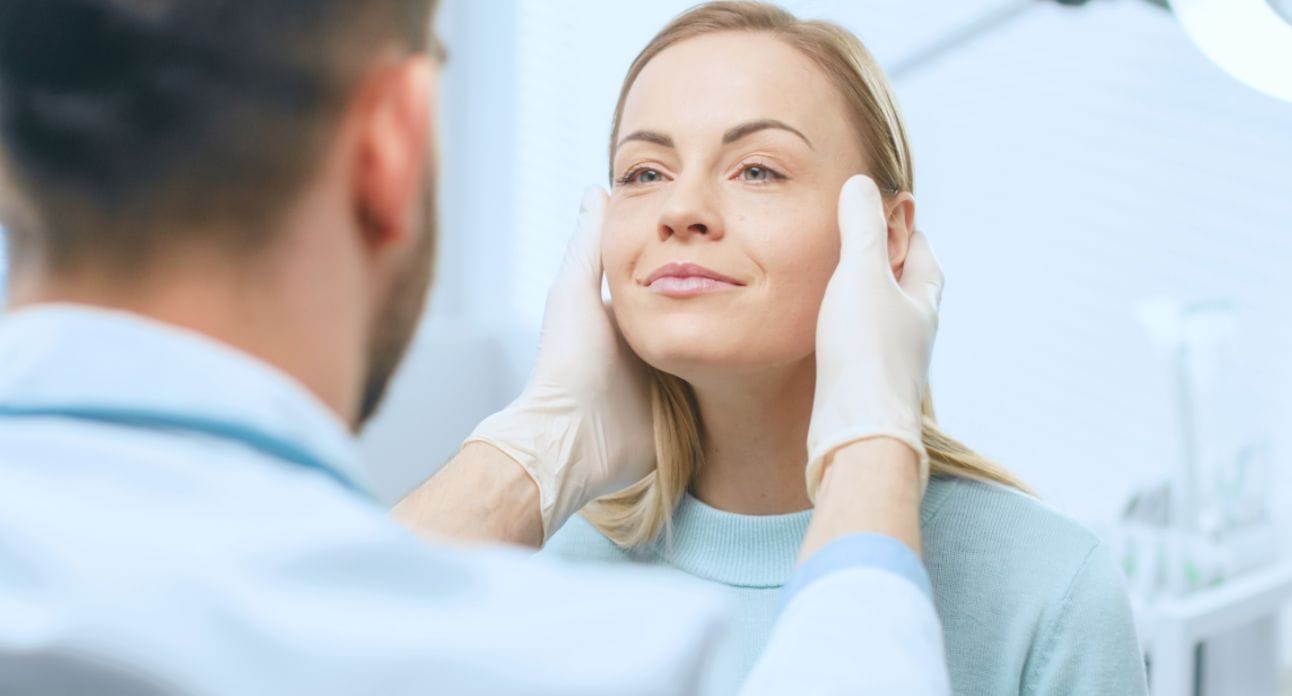
Reasons to Use SEO in Your Plastic Surgery Site:
- Increase new patients (traffic) to your site.
- Improves online presence.
- Creates exposure to the right people based on keywords
Even if the competition is not too high right now, it will be as more and more medical marketers catch on to SEO strategies and their beneficial outcomes. Use this guide to market your services and attract the right demographic to your website and practice.
If you ever get stuck on a certain aspect of your website, don’t worry, we are more than happy to help. Just book a Free Strategy Session with us so we can continue growing your medical practice.


